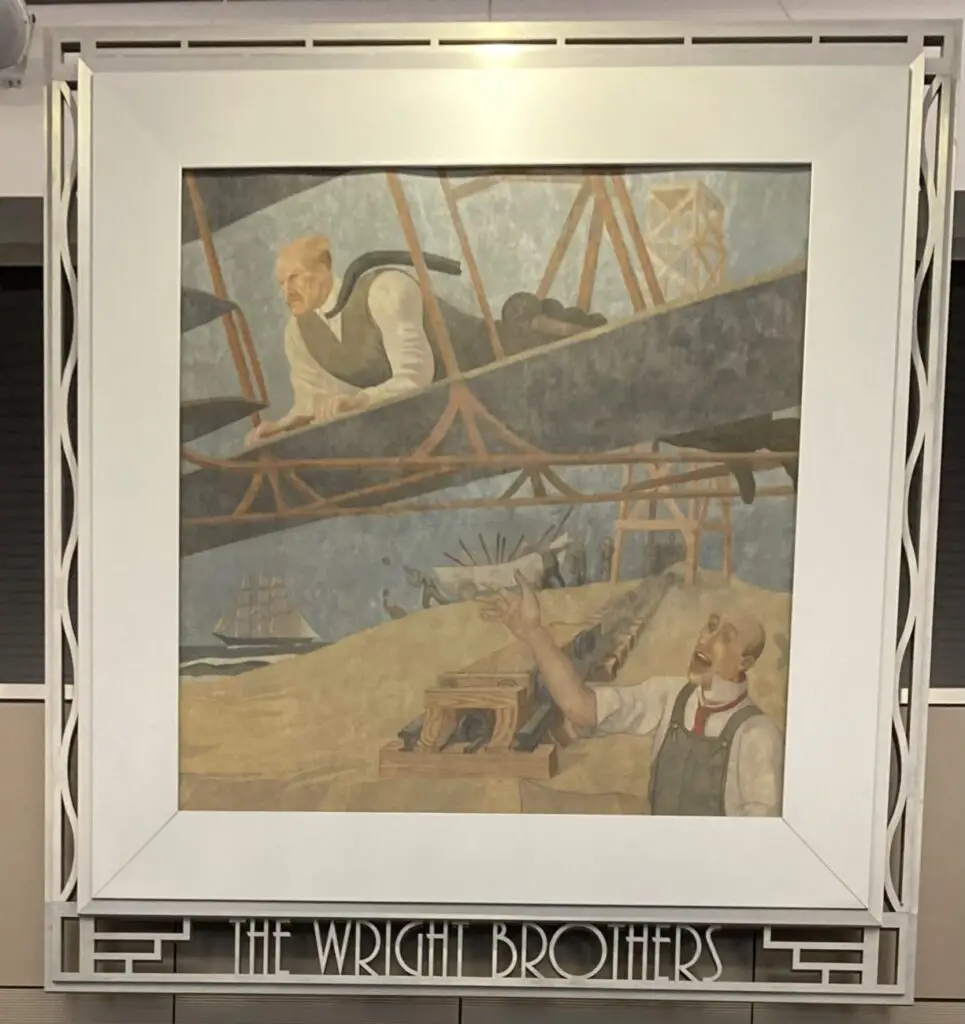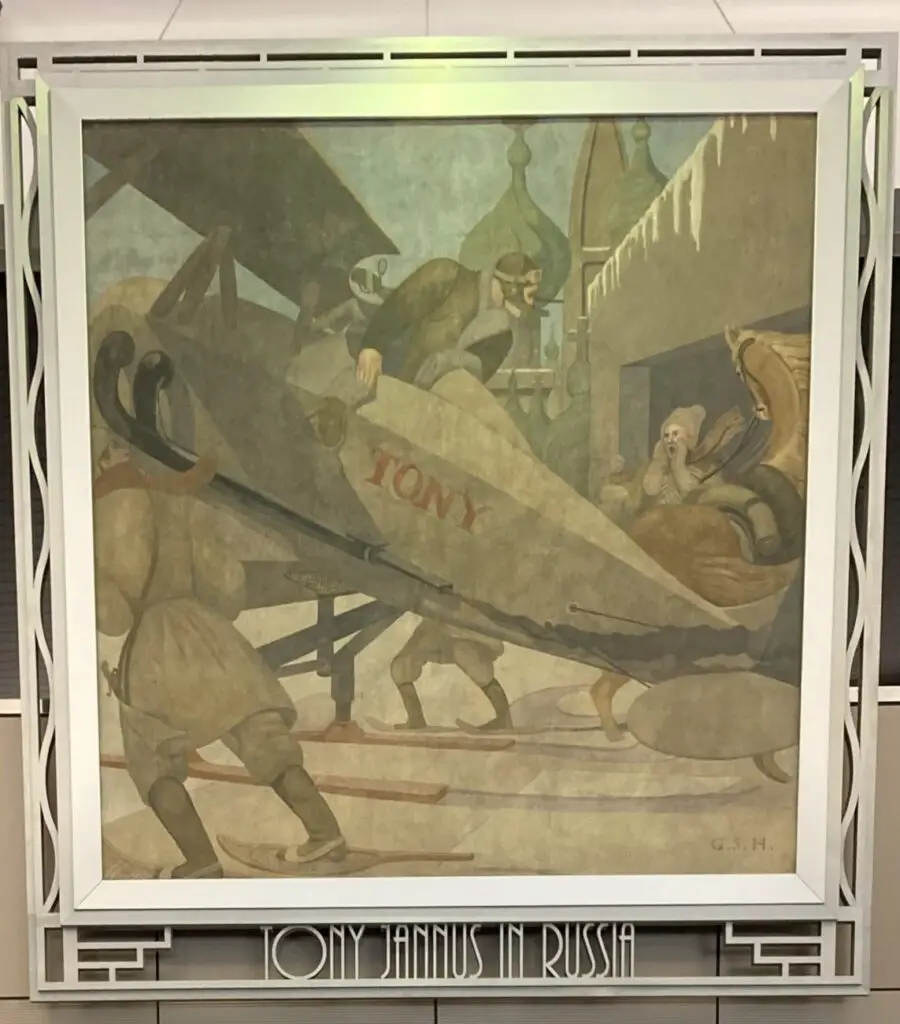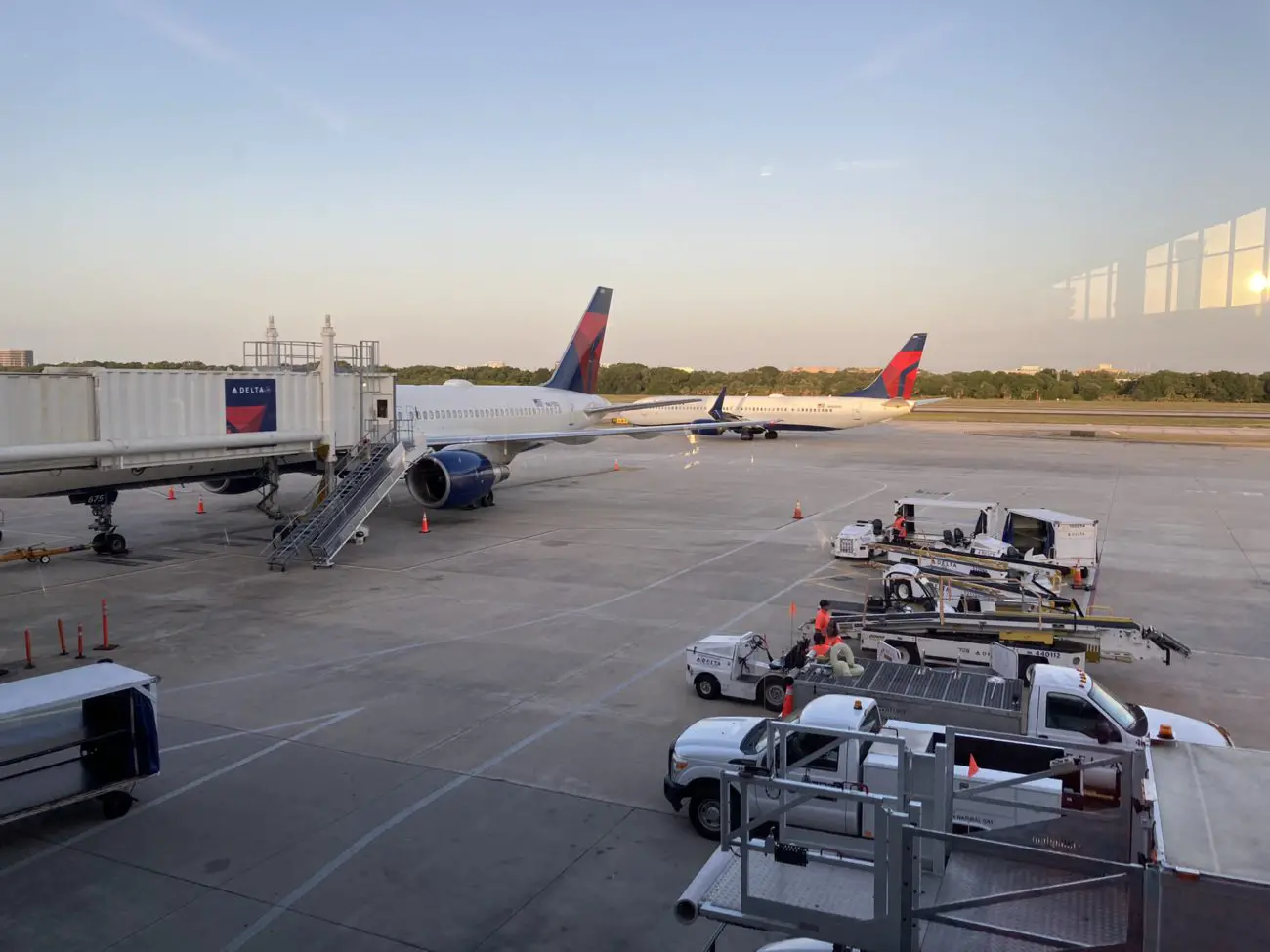While traveling back to Detroit, I noticed some large murals along the walls of terminal E at the Tampa International Airport. The style was unmistakable. They depicted various stages of aeronautics development in the manner familiar with the Post Office murals placed during the Great Depression. I looked around to see if there was a description of the artwork. Sure enough, there was a small lonely pedestal in the corner of the terminal. It was dusty and easy to overlook. However, it contained a wealth of information about each mural. Here are the contents of those descriptions for each mural. It will save you a trip to see WPA art in Tampa.
What Was the WPA, And When Were the Murals Made?
The Works Progress Administration authorized a budget of $105,343 in August 1935 to build the Peter 0. Knight Airport municipal airport on Davis Island. Thousands of government building projects were completed under the WPA. This endeavor epitomized the government’s efforts to recover from the Great Depression.
Thirteen thousand playgrounds, 6,000 schools, 2,500 hospitals, 78,000 bridges, half-million road upgrades, new construction, and 800 airports were the WPA’s nationwide construction projects. President Franklin D. Roosevelt had a tremendous job as the country’s economy struck rock bottom during the Great Depression.
The WPA was established to aid the nation’s recovery, restoring the American people’s morale. The Federal Writer’s Project and the Federal Arts Project were founded due to Eleanor Roosevelt’s influence. Their goal was to promote art and culture and generate opportunities for unemployed artists. The Roosevelts believed that providing access to the arts was critical to instilling a sense of culture in the American people. Roosevelt thought that this exposure would raise the standard of living in the United States.
Countless Americans watched their first theatre play or piece of original artwork because of the WPA’s efforts. Thousands of people were also spared from poverty and misery because of the WPA. For more than a decade, the government hired artists from all disciplines, including theatre, dance, music, photography, and literature. The work produced during these years demonstrated the creative spirit’s enduring presence in the face of such adversity. It was the first and final occasion the US government took such an active part in arts promotion.
George Snow Hill was commissioned to paint the seven murals initially held in the Peter 0. Knight Airport is now housed at Tampa International Airport’s Terminal E as part of this Federal Arts Project in 1939.
“The federal art project of the works progress administration is a practical relief project, which also emphasizes the best tradition of the democratic spirit. the WPA artist, in rendering his own impression of things, speaks also for the spirit of his fellow countrymen everywhere. I think the WPA artist exemplifies with great force the essential place which the arts have in a Democratic society such as ours.”
FRANKLIN DELANO ROOSEVELT
Artist George Snow Hill
George Snow Hill was a local artist who lived in Lakewood Estates in St. Petersburg from 1932 to 1969. He studied abroad and got various accolades and distinctions before arriving in Florida. Painting murals in oil on canvas was his love. Hill was commissioned to create seven murals for Tampa’s newly completed Peter O’Knight Airport in 1939 as part of the WP Federal Arts Project. Davis Island is the location. The airport was one of Roosevelt’s numerous construction projects designed to help the economy recover. Until its removal in 1965, these paintings adorned the Peter O. Knight Airport.
The canvas was immediately affixed to the concrete in the airport terminal during installation. Unfortunately, due to the moisture absorption through the walls, a significant amount of mildew forms. Before being moved to Tampa International Airport for storage, Hill completed the initial repair of all seven murals.
The Art of Flight – WPA Murals Find a Home at TPA
The WPA paintings that had been on exhibit at Tampa International Airport’s Airside E Terminal had finally found a new home. Local artist George Snow Hill was commissioned to create seven murals for Tampa’s newly completed Peter 0. Knight Airport in the late 1930s. Hill used a triptych to depict the first scheduled airline flight in history, including contributions from Icarus and Daedalus, Archimedes, The Montgolfier Brothers, Otto Lilienthal, Tony Jannus, The Wright Brothers, and a triptych.
When Peter 0. Knight Airport was demolished in 1965, and the paintings were removed and restored by George Snow Hill himself. Only the triptych and the Wright Brothers painting remained in the airport’s executive suite after being transported to the new terminal building in 1971. The others were folded up and stored for years, undisturbed. Their storage conditions harmed their state, and when they were discovered, they were in serious need of repair. In 1985, the airport began discussing a mural preservation project, and it is now pleasing to say that those plans have come to fruition. The new Airside E Terminal was created expressly to showcase these paintings.
Archimedes, Tony Jannus, Otto Lilienthal, History’s First Scheduled Airline Flight Arrives in Tampa, The Wright Brothers, Icarus & Daedalus, and Montgolfier Brothers
Icarus & Daedalus
According to Greek mythology, King Minos summoned Daedalus and his son Icarus from Athens to the island of Crete to construct a palace to house the king’s treasures. They succeeded in creating the Labyrinth, a tangle of hallways and rooms. Any thief who broke in would never be able to go out. The fearsome Minotaur, who was half man and half bull, was permitted to dwell there for added security.
After completing the mission, Daedalus and Icarus were imprisoned within the Labyrinth that they had created. Although the King was happy with his new, safe castle, he was concerned that its designers would reveal the escape’s secret. So Daedalus designed a strategy for reclaiming his son and himself. First, he built enormous wings for them using his talents as an inventor and artisan.
They devised a strategy to flee the tower by soaring into the air and away from King Minos. Daedalus built the wings’ structure out of wood lattice, then covered them in feathers. Daedalus told his son, Icarus, not to soar too high after testing his creation since the heat from the sun would melt the wax that kept the feathers on the wings and lead him to crash into the sea. He also advised against flying too near the sea since the water’s mist might cause the wings to disintegrate.
Icarus was deafeningly deafening. He disobeyed his father’s caution and flew too close to the sun since he was excited about flying. His wings crumbled when he realized his father’s wisdom too late, and he drowned in the water below while Daedalus soared safely to Sicily. The Daedalus and Icarus tale is occasionally used to teach the value of moderation or avoiding going to extremes.
Montgolfier Brothers
Many experimenters and designers of aviation were Jacques Etienne Montgolfier (1745-1799) and Joseph Michel Montgolfier (1740-1810). The brothers were French locals who did most of their work there. The invention of the hot-air balloon is credited to these ingenious brothers.
The family’s paper production business provided them with easy access to the resources they required for their research. Joseph decided to construct his cloud after numerous inspections of the sky and clouds. He was able to get a taffeta envelope packed with hot air to ascend to the ceiling with Etienne’s aid. This discovery, which occurred in November 1782, convinced the two that they were on the verge of making significant scientific advances.
The brothers gave the first public display of their new hot-air balloon on June 4, 1783. The balloon was massive, with a circumference of 110 feet and about 500 pounds. This journey, which rose to 6,600 feet before gradually returning to earth, was a remarkable success and drew worldwide interest.
They kept testing when they realized the heated air gave their balloon rise. The Montgolfier brothers launched a balloon carrying a sheep, a duck, and a rooster in September 1783, making it the world’s first accompanied flight. This monumental feat is shown in this mural.
Pilatre de Rozier, a science instructor, and Marquis d’Arlandes, an infantry officer, became the first human passengers in one of the Montgolfier Brothers’ hot-air balloons on November 21, 1783. They soared above Paris for 9 kilometers.
Otto Lilienthal
Otto Lilienthal (1848-1896), known as the “German glider pioneer,” was a great engineer and inventor. He looked at bird flight mechanics and aerodynamics. He recorded the results of his numerous studies on various wing forms. This study gave the most acceptable aerodynamic data available at the time. Many subsequent innovators (including the Wright Brothers) drew inspiration from his work.
Between 1891 and 1896, Otto conducted approximately 2,500 successful glider flights. He flew 18 different types and designed them all. His most impressive feat was gliding over 985 feet and remaining aloft for 12 to 15 seconds.
He had a lot of success studying wing forms and flying, but one thing was missing: control. Because it was the only way offered at the time, his technique of changing body weight to preserve stability was well received. However, in the catastrophic accident on August 9, 1896, this control mode proved to be highly restricted. A blast of wind caused Lilienthal’s glider to stall in the hills outside Berlin, and he was unable to restore power.
The most remarkable person in nineteenth-century aeronautics has been dubbed Otto Lilienthal. His interest in flight prompted him to research object lifting power, the optimal wing form, and the movement of the center of pressure with these various shapes, all of which are vital in aircraft stability.
The Wright Brothers

Orville (1871-1948) and Wilbur (1867-1912), the Wright Brothers, were two of America’s most famous innovators. Orville, the accomplished engineer, and Wilbur, the creative genius, set out to build a robust and practical machine that still flies today. After reading about Otto Lilienthal’s successful gliding experiments in Germany, Wilbur got fascinated by the possibility of mechanical flight.
The Wright Brothers’ engineering was superior to their contemporaries’ trial and error tactics, and this proved to be the secret to their success. Their design and engineering innovations shaped the development of aviation in the twentieth century. They reasoned that flying depended on three concepts: the form of the wings, which served as a method of propulsion, and control. Others had concentrated on the first two issues, but the Wright brothers realized that figuring out control was crucial.
Orville and Wilbur Wright announced that they would fly the world’s first airplane, the Wright Flyer, on December 17, 1903. Everyone was dubious. Only five people were there on the beaches of Kitty Hawk, North Carolina, to witness the brothers’ first successful powered flight, which lasted 49 seconds and covered a distance of 852 feet.
The brothers were given a patent for their flying machine three years after their initial flight, and in 1908 they agreed with Theodore Roosevelt to build and fly one of their machines for the US Army Signal Corps. Wilbur conducted his demonstration flight around a racetrack in France on August 8, 1908, landing perfectly. This two-minute flight awed the tiny audience of onlookers and earned the Wright Brothers international renown.
Tony Jannus in Russia

Tony Jannus, who was born in Washington, D.C. in 1889, was a key figure in the development of commercial aviation. In 1910, Jannus was assigned to install a marine engine in a modified Curtiss-type airplane, which piqued his interest in flying. In 1911, he was engaged as a flying teacher by Benoist (pronounced ben-wah), and he exhibited Benoist planes at several exhibits.
He achieved a record for carrying three men on a ten-minute flight the next year, in 1912. This established a passenger-carrying record in the United States. He also established an aircraft distance record by flying 1,973 miles from Omaha to New Orleans. In 1913, Tony achieved a new record by transporting a passenger 251 miles in four hours and 15 minutes. Tony Jannus, however, did not have a long life.
On October 12, 1916, this artwork portrays Tony boarding a Curtiss H-47 that he was testing for the Russians. Engine failure caused the airliner to fall into the Black Sea. Jannus was just 27 years old when he died. His remains were never discovered.
History’s First Scheduled Airline Flight Arrives in Tampa
Percival E. Fansler started the St. Petersburg-Tampa Airboat Line on December 4, 1913. This was the first airline to offer a scheduled flight over Tampa Bay, which took 23 minutes. On January 1, 1914, the maiden flight was conducted. Tony Jannus piloted a single-engine Benoist (pronounced ben-wah) Flying Boat with a 75 horsepower motor. The cities of Tampa and St. Petersburg were the first two places in the world to enjoy regularly scheduled airplane service as a result of this occurrence.
The new St. Petersburg-Tampa Airboat Line was open six days a week, with two round-trip flights every day. Scheduled flights cost 55.00 each way, while non-scheduled flights cost 510.00-520.00. For four months, the Airboat Line was in operation. A total of 1205 people were transported in this short time, demonstrating to the globe that air travel can be profitable.
Each year, the Tampa and St. Petersburg Chambers of Commerce honor an individual who has contributed to the growth and enhancement of commercial aviation.
Archimedes
Archimedes (287-212 B.C.) is credited with creating many of the mathematical formulae that are still used today. This Greek mathematician dedicated his life to experimentation and investigation. He enjoyed constructing theorems and math. His geometric talents were remarkable, especially when it came to computing area and volume. Archimedes was completely committed to mathematics and had a deep passion for it. Archimedes created equations guiding the floating of things through liquids and gases thousands of years before flying became a reality.
Restoration of the Murals of WPA Art In Tampa International Airport
It took a lot of work to restore these seven murals. The procedure was delicate, intricate, time-consuming, and unpleasant. The Airport Public Arts Committee chose James Swope Fine Arts Conservation, Inc. of West Palm Beach, Florida to repair all of the murals.
The restoration of these historically significant works of art to a presentable state presented several problems. Many had been stored without protective-facing tissue on the front for years and had significant paint loss. Some paintings were hung between two boards and secured top and bottom to prevent curling, but the vertical sides were left exposed, and the edges were twisted and stretched by the weight. Active mold development and ancient mold spore stains were observed, which may eat through paint layers and irreversibly damage the paint over time.
To support the pigment, Japanese tissue with cornstarch paste was placed on the face of the murals once all of the issues were identified. Patches were fitted in the gaps after the murals were cleaned and relined with new canvas backing, and the Conservationist began in-painting the missing pictures. The patching is hardly undetectable. Depending on the degree of the damage and the amount of repair necessary, each mural took anywhere from six to nine months to restore.
The Airside E at Tampa International Airport was reconstructed to fit all seven paintings. Each mural is strong on its own, but the artist intended for them to be presented as a group. They portray the tale of a unique period in the history of aviation when taken together.
Related Reading
Today In 1917: Michigan Helps Lead Way Toward Women’s Suffrage
12 Weird Michigan Laws That Set It Apart from Its Neighbors?
13 Extraordinary Mansions in the United States
Back in 1970: Clifford Wharton Named MSU President – 1st African-American to Lead A Major University



